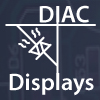Diac Display Technology FAQs
What is a DIAC?
A DIAC (a DIode for AC) is a simple electronic device commonly used to switch 60Hz AC power cycles. It is a two-terminal, bidirectional switch that turns ON and OFF automatically. As voltage (positive or negative) is applied across a DIAC that exceeds its breakover voltage, it turns on, self-latching into a conductive state. When conducting, the voltage drop across a DIAC is minimal and there is no current limiting. Current flow through the device until it decreases to a level below its minimum holding current, where it turns off. DIACs are readily available electronic components.
What is a DIAC Memory Cell?
A DIAC memory cell consists of a capacitor connected in series with a DIAC. The capacitance provides ON or OFF memory states. Pulses are applied across the cell to write or erase the memory state. Each pulse is capacitivly coupled by the capacitance to the DIAC. A higher voltage pulse is used to write (i.e. set ON) the memory cell by triggering breakover conduction; i.e. a discharge. Once set ON, a lower voltage pulse may be used to re-trigger the cell for maintaining the memory state. With each pulse transition, the capacitance is charged, or discharged and limits the current flow through the cell. The voltage rating of the DIAC and the value of the capacitance determine the power consumed by each discharge.
What is a DIAC Display?
A DIAC display is a relatively simple electronic pulse driven display technology. Each pixel consists of a DIAC memory cell and an LED or OLED pair to emit light on each discharge. The capacitance maintains the memory state and limits the current flow through each LED or OLED. A DIAC display is driven with the same subfield driving method as plasma TVs. Subfield driving consists of dividing each video frame into brightness weighted subfields. Each subfield has an addressing time period where pixels are turned on according to the desired image. Subsequent to the addressing period, each subfield has an illumination period having a number of driving pulses to provide the brightness weight of the subfield. With a DIAC display, the DIAC controls the operating voltage and the capacitance limits the current through each illumination element to maintain uniform brightness levels across the display.
When did Mr. Marcotte Invent DIAC Displays?
He came up with the idea while considering alternative plasma display driving methods in 2011. If a DIAC behaves like a gas discharge, why not try building a solid-state plasma cell? Within a couple of hours, he had his first DIAC display cell working. He filed a patent soon thereafter and has recently received a notice of allowance for the claims in the application.
Mr. Marcotte is currently developing this technology utilizing readily available components. Working on a prototype board with 0.1in spacing, his RGB pixel sixe is 0.3in square. While this is a huge pixel for typical displays, it demonstrates the scalability of the technology up to billboard-size displays.
What are the Advantages of a DIAC Display?
DIAC technology is well known in the field of power supply electronics as a semiconductor-based switching device made from alternating p-type and n-type semiconductors. As a simple-stacked structure, DIACs can be readily fabricated; potentially being easier to fabricate than active matrix TFT's.
DIACs are a controllable and consistent alternative to plasma discharge technology. DIACs use the same principle of breakover conduction as dischargeable gasses like neon and xenon. The DIAC's semiconductor stack is designed to breakover (i.e. switch ON) at a precise voltage. Plasma technologies require high voltages and precise fabrication processes. Operationally, plasma technology is difficult to control since the gas breakdown voltage can be quite variable and the discharge itself is inefficient.
DIAC displays can be fabricated as energy-efficient, high-resolution, organic LED displays for TV, tablet, cell phone and micro-display applications. Alternatively, they can be fabricated as LED displays of virtually any size using commercially available parts.
What is wrong with AMTFT-OLED technology?
Manufacturers have been working on this technology for years now. The active matrix thin film transistor (AMTFT) was designed for LCDs which are controlled by a voltage level under a zero current condition. OLEDs are not zero current devices. An OLED's brightness depends on the amount of current flowing through it. TFT technology tries to control OLEDs with a voltage level, but OLEDs require a continuous current flow. TFTs were not designed to control the amount of current required by LEDs and OLEDs. Thus, to properly control an LED or OLED, a current control mechanism is desired.
Can DIAC Display Technology Solve AMTFT-OLED Problems?
Yes. DIACs, LEDs and OLEDs are all devices designed to conduct current. The capacitance and the DIAC of each DIAC display pixel provide a control mechanism. They control the amount of current through a pair of LEDs or OLEDs. Driving circuits apply pulses to charge and discharge the capacitance of each pixel. Each driving pulse produces a specific amount of current and produces a specific amount of light. Overall power and brightness is controlled by the voltage of the pulses, the value of the capacitance and the number of pulses applied. DIACs are current devices designed according to the current requirement of each pixel. Thus, DIAC display technology is better suited to LED and OLED technology than active matrix TFT technology.
